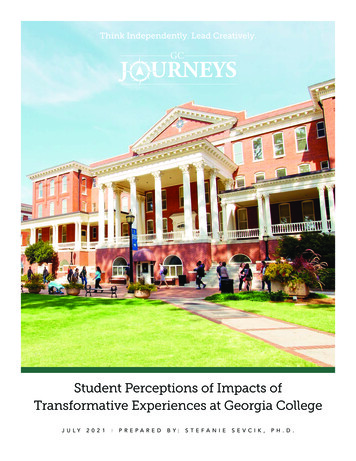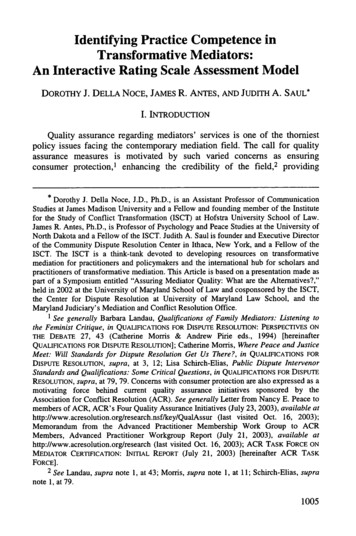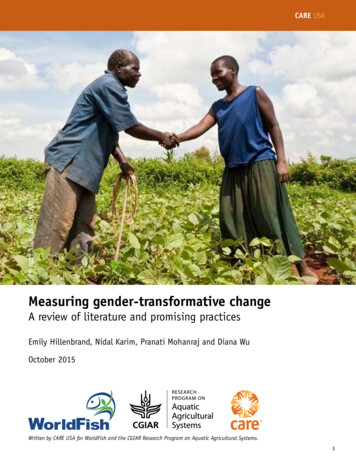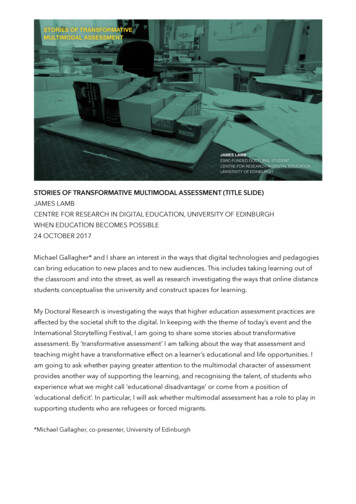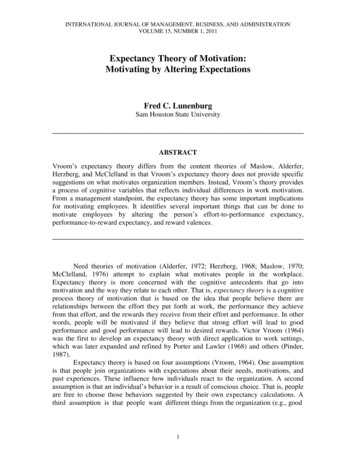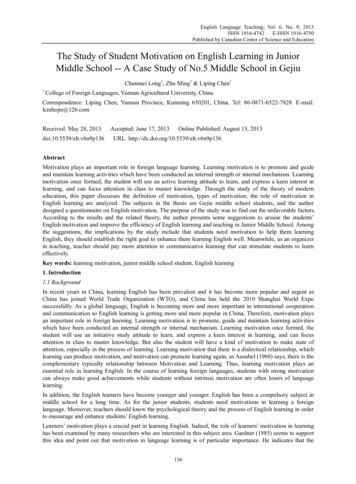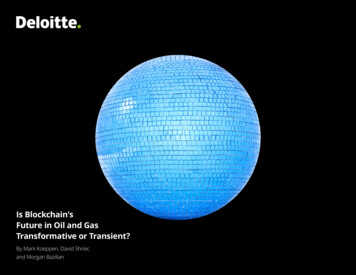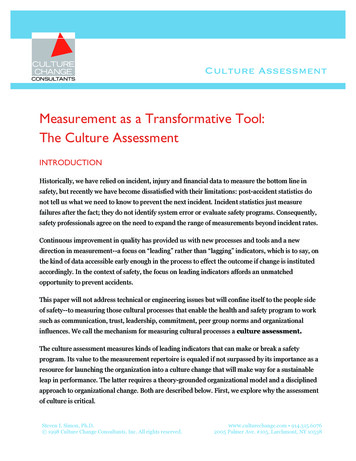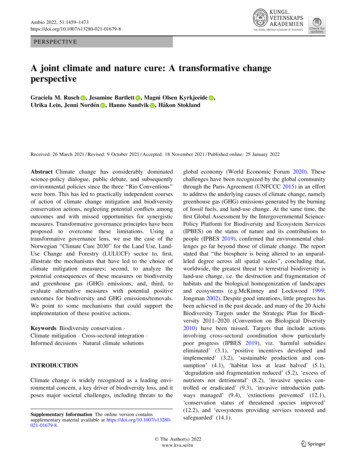
Transcription
SHB: Medium: Quantitative Observational Practice in Family StudiesPanayiotis (Panos) Georgiou,University of Southern California1059095Motivation: Transform observational behavior analysisthrough a computational framework Offer new analysis capabilities and empower the mentalhealth experts Model emotionally-rich human interactions through signalprocessing and machine learningTransformative: Can improve mental healthcare and observational practice Can empower and provide new behavioral cues to experts(e.g. psychologists) Can enable scalability and knowledge discovery through bigdataBroader Impacts: Technologies can apply to other applicationdomains, e.g. meetings, negotiations, focus groups Encourages cross-disciplinary exposure andknowledge transfer Identifies new behavioral metrics, e.g. vocalentrainmentContacts: Panayiotis (Panos) GeorgiouAssistant ProfessorUSC Viterbi School of Engineering Collaborators:S. Narayanan, B. Baucom, G. Margolin http://sail.usc.eduTechnical Approach: Use real couple therapy interactions Use Signal Processing techniques on the acoustic,lexical and visual channels. Extract meaningfulfeatures (e.g. automatically transcribe, head motion) Use Machine learning to learn from human ratings Progress: Accurate predictors from all channels: acoustic,lexical, head motion. Novel behavioral metrics of vocal entrainment andhead-motion similarity Novel methods for detecting salient regions towardsbehavioral summarization
Crafting a Human-Centric Environment to Support Human Health NeedsDiane J. Cook and Sajal K. DasWashington State UniversityNSF Grant #I1064628Motivation: Design smart environment technologies to performautomated health assessment and interventionTransformative: Our team combines expertise from machine learning,pervasive computing, and clinical neuropsychology We are designing and clinically validating methods toperform automated functional assessment and interventionBroader Impacts: Data collected in the smart homes is cleaned,anonymized, visualized, and disseminated Half of the students and faculty involved in thisproject are women or from underrepresented groups Research was integrated into a multi-disciplinaryGerontechnology classContacts: Diane J. CookWashington State University, cook@eecs.wsu.edu Sajal K. DasMissouri S&T, sdas@mit.edu http://ailab.wsu.edu/casasTechnical Approach: We perform real-time activity recognitionsmart home sensor data “out of the box” Machine learning techniques map activityparameters to assessment values Activity forecasting drivesactivity prompting interventionProgress: We collected sensor data in 40 homes with older adults We observe a statistically significant correlation (r 0.79)using supervised machine learning and (r 0.57) usingunsupervised learning between smart home sensor andclinical scores for n 179 older adult participants.
Novel Computational Techniques for Cardiovascular Risk StratificationSatinder Singh, Univ. ofMichigan, NSF SHB1064948Motivation: Cardiovascular illness leading cause of death world wide There exist many potentially life-saving therapies Need to know which patients are at high risk so thattherapies can be properly matched to patientsTransformative: Provides a novel approach to risk stratification usingphysiological signals Can lead to simultaneous improvement in outcomes andreduction in costBroader Impacts: Work can be extended to predict impact of varioustherapeutic interventions Many of the techniques used can be applied to otherquasi-periodic signalsContacts: John Guttag MIT Satinder Singh, Univ. of Michigan Zeeshan Syed, Univ. of MichiganTechnical Approach: Convert ECG signals to multiple kinds of moreabstract time series Use techniques from computational biology anddata mining to find relationships between those timeseries and outcomes of interestProgress: Improved existing methods for risk stratifying a patientsfollowing an acute coronary syndrome Results published in high impact medical and computerscience venues
SHB: Medium: Self-Care Management: Patient-Centered Diabetic Wound Care Using Smart PhonesDiane M. StrongWorcester Polytechnic InstituteIIS-1065298Motivation: Diabetes self-care management is complex, involving regularmonitoring of glucose, weight, physical activity and diet For patients with diabetic foot wounds, regular monitoring and carecan accelerate wound healing and reduce the need for amputation Timely feedback can improve patients’ awareness of their health anddiabetes and reduce the risk of complicationsSelf Management:(a) Main menu(b) Glucose readings(c) Weekly glucose,weight, activityfeedback(a)(b)(c)Transformative: Our app enables a spectrum of data-driven interventions via mobiledevices anywhere anytime Our wound image analysis algorithms provide an objectiveassessment that can transform medical wound evaluation practice These algorithms can be applied to assess the clinical healingprogress of other types of wound imagesWound Assessment:(d) Original wound(e) Original andboundary detectedwound image(f) Original, boundarydetected and coloranalyzed wound(d)(e)(f)Broader Impacts: Enables patient-centered self-management of Type 2diabetes, a condition that affects over 8% of the U.S.population, based on mobile devices Enables tracking of chronic wound healing progressquantitatively on a smartphoneTechnical Approach: Using focus group input, design and implement a smartphone appwith intelligent feedback to help patients better manage their diabetes Implement and test two wound boundary determination algorithms:the mean shift based algorithm for smartphone implementation andSVM binary classifier based algorithm for use in wound clinicProgress:Contacts: Worcester Polytechnic Institute, Diane M. Strong, PI,Emmanuel Agu, Peder C. Pedersen, Bengisu Tulu, co-PIs Collaborator: UMass Medical School http://www.wpi.edu/ diabetesfonecare The Sugar app (without the wound module) was evaluated forusability with 5 users in a lab. A take-home study is scheduled forJuly, 2014 The wound module was tested in the UMass Medical School’sWound Clinic for one year and modified accordingly The completed Sugar app (including the wound module) will betested in a home study starting September 2014
SHB: Medium: Assistive Cloudlet-Based Mobile Computingfor the Cognitively ImpairedGabrielMahadev Satyanarayanan, Carnegie Mellon University, IIS-1065336Motivation: Use wearable devices such as Google Glass as a real-timeassistive system for cognitively challenged persons Combine context-aware real-time scene interpretation withdeep reasoning to proactively assist userTransformative: Create cognitive assistive systems that work “in the wild” Dynamically inject sensing into the environment by enablingscene interpretation on wearable device (e.g. Google Glass) Create cloudlet architecture for offloading compute-intensiveand data-intensive algorithms in computer vision and machinelearning from lightweight wearable hardware.Broader Impacts: Potential to improve the quality of lives ofindividuals whose cognitive capabilities havedeclined due to natural aging, illness or traumaticinjuries (estimated at 20 million Americans). Safe use and compliance with instructions inrehabilitation and management of chronic illnessContacts: Mahadev Satyanarayanan, Carnegie Mellon University Martial Hebert (co-PI), Daniel P. Siewiorek (co-PI) http://elijah.cs.cmu.eduTechnical Approach: Coarse-grained parallelism across cognitive engines Pub-sub sensor streaming mechanism to amortize cost ofoperations such as video decoding 2-level token-based end-to-end flow control to limit queuinglatency due to slow cognitive enginesProgress: Prototype implementation of muli-tiered mobile systemarchitecture that offers tight end-to-end latency bounds oncompute-intensive cognitive assistance operations, VM-based extensibility for easy customization, withoutimposing unacceptable latency and processing overheads onstreaming video from Google Glass. Graceful degradation of cognitive assistance services in theface of network failures
Non-Intrusive Multi-Patient Fall-Risk Monitoring in Health Care FacilitiesThurmon Lockhart and John Lach,Virginia Tech and University of VirginiaAward Number:1065442 and1065262Motivation: Falls are the most common cause of elderlyindividuals being forced to transition from independentliving to assisted care Researchers have had limited success achievingaccurate fall risk assessment in diverse patient sets Currently available motion analysis technology doesnot allow field assessments of gait and postureparametersTransformative: This project addresses the fundamental scientificissues associated with using Body-Sensor-Networksfor continuous, longitudinal, non-invasive mobilityanalysis and fall risk assessment in the elderlyBroader Impacts: Enable a new paradigm in elderly patient careto target fall prevention to high fall riskindividuals before fall incidents occur Crossing the disciplinary divide betweentechnology and healthcare Use of energy efficient BSNs in a variety ofapplication domainsContacts: Thurmon Lockhart, Virginia Tech John Lach, University of Virginia Karen Roberto and Dong Ha, Virginia Tech http://www.locomotion.ise.vt.edu/ http://wirelesshealth.virginia.edu/Technical Approach: Explore techniques to balance energy consumption Identify the minimal set of on-body sensor locations determine the appropriate algorithms to identify fallprone individuals Validate the TEMPO-based data collection andprocessing algorithms in a naturalistic HCF livingenvironment.Progress: collected a total of 300 elderly individuals andassociated medical history database from severalsenior centers using the TEMPO validating the results on 170 participant data
Mobile Wellness ToolkitRichard Anderson, Gaetano Borriello, Beth Kolko (University of Washington)Noah Perin (PATH)Grant IIS-1111433Motivation: Underserved populations around the world suffer from lack ofaccessible and affordable health care. Existing health care systems in low-resource environments areacutely understaffed and overcrowded. There is great potential for more effective and efficient workflowsin these environments.Transformative: We design and deploy affordable tools that improve existingworkflows. Our initiatives are embedded in local community practices. We work closely with partner organizations that have extensivefield experience.Broader Impacts:Technical Approach: The design of affordable technologies for providing betterhealth care to underserved populations around the world. We design solutions that take advantage of messaging,data processing, photo and video capabilities of mobiletechnologies to improve health care practices in lowresource environments.Contacts: Richard Anderson, Gaetano Borriello, Beth Kolko,Noah Perin http://mwt.cs.washington.eduProgress: We have designed and deployed technologies that have beentested in India, Laos, Mozambique, Ghana, Zimbabwe, SouthAfrica, and Kenya for antenatal and postpartum health care,human milk banking, diagnostics, immunization, and cold chainmanagement.
Computational Algorithms for Predictive Health AssessmentPredictive health assessment frameworkBroader Impacts: This work enables the development of behavioralmodels by identifying daily activities of elderly Supports evidence-based medicine by providingsummaries of sensor data for the clinical personnel The algorithms developed in this work can beapplied to other wearable and non-wearable sensorsContacts: Mihail Popescu, University of Missouri, Columbia, MO Co-investigators: M. Skubic, J. Keller, R. Koopman edictiveHealth2014.htmlMihail PopescuUniversity of MissouriNSF Grant #IIS-1115956Motivation: Develop machine learning algorithms based on sensor datathat account for the patient health context Early detection of acute illness onset or health changes leadsto better prognosis Sensors and machine learning technologies enable aproactive, timely, person-centered approach to healthcareTransformative: Transforms healthcare from reactive to proactive Transforms healthcare from institution-centered (hospital)to home-centered Transforms healthcare from disease-centered to wellnesscenteredTechnical Approach: Automatic segmentation of sensor data oriented towardactivity identification [3] A temporal Smith-Waterman similarity of sensor sequences [1] Early illness recognition based on the presence of abnormalactivities (not similar enough to previous patterns) [2] Early illness recognition based on the absence of normalactivities [4]Progress:1. Z. Hajihashemi, M. Popescu, “Improving Health Pattern Recognition Using Smith WatermanAlgorithm and NLP”, AMIA Fall Symposium, Washington Dc., Nov. 13-16 2013.2. Z. Hajihashemi, M. Popescu,” Detection of Abnormal Sensor Patterns in Eldercare”, E-Health andBioengineering Conference (EHB), 21-23 Nov. 2013, Iasi, Romania, 2013, pp. 1-4.3. Z. Hajihashemi, M. Yefimova, M. Popescu, “Detecting Daily Routines of Older Adults Using SensorTime Series Clustering”, accepted to EMBC 2014, Chicago, IL.4. Z. Hajihashemi, M. Yefimova, M. Popescu, “A New Illness Recognition Framework Using FrequentTemporal Pattern Mining”, submitted to SmartHealthSys 2014, Seattle, WA.
SHB: Small: An Assistive, Robotic Table [ART] Promoting Independent LivingKeith Evan GreenClemson UniversityNSF #IIS-1116075Motivation: To develop “ART,” a smart, interactive table supportingindependent living, at home and in medical facilities. This is anew frontier for SCH. To develop a novel robotic surface that rehabilitates the armsof post-stroke patients. This is a new frontier for robotics. To design a smart interface for users with cognitive and/ormobility issues to best communicate with ART and othersmart furnishings. This is a new frontier for gesture-basedcomputer interfaces.Transformative: Computing will inevitably extend to the built environment from the scale of furniture to the metropolis - supporting andaugmenting an increasingly digital society.Broader Impacts: “ART” suggests the potential of larger-scaled,digital-physical artifacts to empower people to remainindependent. This research recognizes Engineering, ArchitecturalDesign and Human-Factors as inseparable.Technical Approach: At the furniture-scale, ART was mostly an integrationproblem that we developed with clinical (hospital) staff. The continuum surface was a design and motion planningchallenge, employing pneumatic actuators. The interface employed a novel machine learning approach.Contacts: Keith Evan Green (PI), Clemson University Ian D. Walker; Johnell O. Brooks, Clemson Univ. ART Project URL (with links to video and papers):http://workgroups.clemson.edu/AAH0503 ANIMATED ARCH/research%20-%20comforTABLE.htmlProgress: We have a full-functioning, final prototype constructedmostly in steel. We are refining/finishing a few details. Results were reported at / published in benchmarkconferences and journals in our disciplines: IROS(Robotics); CHI, HERD (Human Factors and Design);& IEEE Trans. (Electrical and Computer Engineering).
Reducing Alcohol Use among College Students Using Virtual Role PlayingVirtual College Life Avatars(inviting participant to party)Broader Impacts: Help participants to be cognizant of theirability to make positive societal differences Build infrastructure for training counselors andresident assistants to address high stresssituations, including drug usage and assault Attract participants to STEM disciplinesContacts: Charles Hughes, University of Central Florida,ceh@cs.ucf.eduJennifer Epstein, Weill Cornell Medical College,jepstein@med.cornell.edu Interactor Simulation Systems, Orlando http://collegelive.orgC. Hughes, UCF IIS1116615J. Epstein, Cornell IIS1116186Motivation: Help college freshmen develop awareness of riskydrinking situations and protective/skills strategies, forself and for others, to help reduce problem drinkingand consequences of those behaviorsTransformative: Use virtual reality to provide a realistic yet safeenvironment for college freshmen to experience peerpressure to drink alcohol particularly in risky ways Provide consistent, age-appropriate behaviors for peersso experiences have face validity in typical party scene Allow evolution of experience to be influenced by user’sbehaviors, both verbal and non-verbal, as well asinteraction with avatarsTechnical Approach: Use avatar-mediated interactive, personalizedexperiences allowing participants to role play Employ low bandwidth networking protocol soexperiences can be delivered remotely Provide immediate feedback for maximum benefitProgress: Developed virtual role playing experience Ran one focus group, two formative studies (n 51),and a related dissertation study by the research team’sgraduate student using the project’s paradigm (n 145) Evolved scenario and software infrastructure based onfeedback from participants and observers
Toward Verifying Smart-Health Infrastructure (SHI) Safety from their Impact on Human PhysiologySandeep K.S. Gupta,Arizona State Universityand IIS 1116385Motivation: For electronic medical devices there is a constant andchanging interaction with the body. Interactions are spatio-temporal, non-linear, time variant,and dependent on context. Some interactions lead to unintended adverse safety events.Transformative: Novel idea of spatio-temporal hybrid models transforms thenotion of system state to space and time. Reachability analysis for medical control applications. Analytical techniques for safety assurance certification.Broader Impacts: Medical control systems such as Artificial Pancreasare prone to failures (nocturnal hypoglycemia). Market approval is risky where patient safety can bejeopardized due to software errors ormisconfiguration of control algorithms. Verification techniques can provide theoreticalguarantees that can be used in safety certification.Contacts: PI: Sandeep K.S. Gupta, Arizona State University Collaborators: Ayan Banerjee (Post Doc), PriyankaBagade (Phd student), Joseph Milazzo (MS student),Paul Jones & Yi Zhang (FDA) https://impact.asu.edu/Smart-Health.htmlTechnical Approach: Spatio-Temporal Hybrid Automata (STHA). Non-linear reachability analysis under free boundaryconditions. Markov chain based analysis of randomized context drivenexecution. Automated code synthesis from verified models.Progress: STHA implementation and reachability analysis [ICCPS’13]and Non-linear hybrid automata reachability analysis usingexponential box splines. Time efficient analysis of context driven physiologicalinteractions [TMC’14]. Health-Dev code synthesizer and clinical studies [BSN’12].
E-textiles for Ambulatory Healthcare MonitoringTom Martin, Virginia Tech, IIS-11166669Lucy Dunne, University of Minnesota, IIS-1116719Motivation: Existing approaches to ambulatory monitoring provide littleor no context for the data, suffer from motion artifacts, andhave low patient compliance due to lack of wearability.Garment for activity classification (left)and stitched stretch sensor (right)Transformative: Our e-textile garments provide a platform for a wide varietyof biomedical sensing. We will automatically annotate physiological data withpatient activity and motions, as well as use patient activity tocontrol data collection We are developing yarn and fabric sensors that can beseamlessly integrated into clothing, improvingcomfort/aesthetics, and consequently compliance.Broader Impacts: The broader impacts include a variety ofapplications in home health monitoring, particularlyfor the elderly and people with disabilities, reducingthe need for office visits and hospital stays.Technical Approach:Our approach involves: creating algorithms for user- and sensor-independentactivity classification using sequences of patient poses. Developing pose and motion sensors in fiber and yarn formfactors.Contacts: Tom Martin, Virginia Tech, tlmartin@vt.eduMark Jones, Virginia Tech, mtj@vt.edu Lucy Dunne, U. of Minnesota, ldunne@umn.edu Project URL:http://faculty.design.umn.edu/dunne/current projects/garment integrated sensing.htmlProgress: An initial version of the user-independent classifierdeveloped and tested with video-based motion capture;initial testing of the classifier with a loose-fitting garment isunderway. Stitch-based stretch sensors that detect stretch and bendhave been developed and fully characterized using threecommon industrial sewing techniques.
Social Tools for Everyday Adolescent HealthElizabeth D Mynatt,Georgia TechNSF Grant #1116801Motivation Prevent and reduce rates of overweight and obeseadolescents in the US Expand the role for social media technologies in promotingsustained health behavior change in adolescentsTransformative Demonstrate how social computing can enable offlinehealthy behaviors using peers as motivators Demonstrate the promise of non-competitive socialcomputing interaction for individual health motivationBroader Impacts: Address adolescent obesity through innovativesociotechnical approaches Empower those most in need of transformativesolutions (inactive adolescents in low-incomecommunities)Contacts: Elizabeth D Mynatt, Georgia Tech Andrew Miller, now at University of Washington reamTechnical Approach: Participant workshops to design social mediaapplications that encourage peer support foreveryday fitness (142 participants) In-the-wild deployments with wireless sensors &custom-built social media platform (83 participants) Mixed methods analysis, including sensed data, logdata, interviews, focus groups & validated surveysProgress: Completed formative design & in-the-wild field evaluationsin two matched schools Published at Pervasive Health 2013, CHI 2014
Computing Robot Motions for Home Healthcare AssistanceRobots autonomouslyperforming tasks inhome-like environmentsBroader Impacts: Home healthcare robots have the potential to assistdisabled and elderly individuals with ADLs,allowing them to safely stay in their homes ratherthan moving to costly institutions. Interactive robotics demonstrations for communitymembers can spur interest in STEM for healthcare.Contacts: Ron Alterovitz and Dinesh ManochaDepartment of Computer ScienceUniversity of North Carolina at Chapel Hill Jennifer WomackOccupational Science and Occupational TherapyUniversity of North Carolina at Chapel Hill Web: robotics.cs.unc.edu/DGMP , gamma.cs.unc.edu/ITOMPPI Ron Alterovitz, University of North Carolina at Chapel Hill,NSF Grant #1117127Motivation: Over 10 million Americans currently need assistance withactivities of daily living (ADLs), and this number is growing. Robots could empower elderly and disabled individualsneeding ADL assistance to remain in their own homes ratherthan be transferred to costly institutions or nursing homes. New software and algorithms are needed to control homehealthcare robots for autonomous, safe assistance with ADLs.Transformative: We investigate new algorithms for computing safe motionsfor home healthcare robots to assist individuals with ADLs. We develop and evaluate new robotics algorithms that arerobust to human variations, handle imprecise real-world data,and generate safe, effective motions in real-time.Technical Approach: Learn robust metrics for ADL task motions from kinestheticdemonstrations provided by healthy humans. The computedmetric serves as a guideline for fast motion planning forinteractions with new care recipients. Develop fast algorithms for real-time motion computation inuncertain, dynamic, and cluttered environments. Achievefast performance using novel algorithms and harnessing thecompute power of multi-core CPUs and many-core GPUs.Progress: Developed fast robot motion planning algorithms utilizingmulti-core CPUs and GPUs and using sampling-basedand optimization-based approaches. Robots learned and executed several assistive tasks.
Wanda Pratt, University of Washington #111718Matchmaking for health: Facilitating Mentoring in Peer Health Communities through Social MatchingWho’s the best match?Motivation: Online health communities offer a broad base of personalhealth expertise from “peer mentors” Finding the right peer mentor with shared circumstancestakes time, effort, and can yield advice that doesn’t quite fitone’s situation Recommending peers with matching interests based on theirdigital traces can help users forge critical health connectionsTransformative: Extends biomedical text processing tools to patient-generatedonline community text Informs design of tools that profile and visually present thegrowing scale of users’ digital traces Deepens our understanding of online health community needsBroader Impacts: Enhance health and wellbeing by advancing theeffectiveness of peer health mentoring Stimulate interdisciplinary research at the nexus ofinformation science and health research Guide development of innovative peer healthprograms that leverage patients’ expertiseContacts: PI: Wanda Pratt, University of Washington Primary Collaborators: David McDonald,Andrea Hartzler , Albert Park, Jina Huh,CancerConnect.com Project URL: blogs.uw.edu/medpal/author/medpal/Technical Approach: Text extraction, recommendation systems,interactive visual design, user-centered designProgress: Development and evaluation of text processing pipeline toextract users’ health interests from online community posts Content validation, interactive prototyping, and usabilityevaluation of user profiles extracted from posts Development of social matching algorithms to recommendcandidate peer mentors with similar health interests andpersonal style
Machine Learning Models for Blood Glucose Prediction in Diabetes ManagementCindy MarlingOhio UniversityNSF Grant #1117489Motivation: Good blood glucose control is key to diabetes management,enabling patients to avoid or delay serious complications Patients do not always know when blood glucose controlproblems are impending Accurately predicting impending problems would givepatients time to take preventative action, enhancingimmediate safety and improving overall controlTransformative: Accurate predictions enable or facilitate applications ofdirect benefit to patients with type 1 diabetes, includingalerts and alarms, decision support, and “what if” analysis toproject the effects of lifestyle choices and treatment optionsBroader Impacts: Improving overall health and quality of life forpatients with type 1 diabetes Reducing costly diabetic complications throughimproved blood glucose control Attracting more women to computing careersthrough a new SmartHealth LabContacts: PI: Cindy Marling, Ohio University Co-PIs: Razvan Bunescu and Frank Schwartz, MD http://ace.cs.ohio.edu/ marling/lab.htmlTechnical Approach: Blood glucose prediction is approached as a timeseries forecasting problem A predictive model is trained for each patient usingfeatures derived from blood glucose, insulin, anddaily life event data Machine learning models are informed by aphysiological model of blood glucose dynamicsProgress: The best model to date makes more accurate predictionsthan the three physicians involved in the study Work continues to improve prediction accuracy, especiallyfor the safety-critical task of predicting hypoglycemia
Use of Gaming Peripherals in Acute Rehabilitation of BalanceFollowing StrokeJames Schmiedeler, Aaron Striegel, & Charles CrowellUniversity of Notre DameIIS-1117706Motivation: Restoration of balance after stroke is critical determinant ofpatient’s long-term assistive needs. Optimizing use of limited therapy time, particularly in acutephase shortly after injury, facilitates functional recovery. High cost of most balance feedback systems limits clinicalaccess & potential for in-home use after discharge.Transformative: Low-cost system accessible to any clinic & most individuals. Quantitative measurement of progress becomes integral part oftherapeutic balance activities, reducing required time spent onnon-therapeutic assessments. Optimized feedback alters patient self-awareness, therapisttreatment plans, & patient-therapist interactions.Broader Impacts: Enhanced quality of life for patients achieving morerapid & fuller recovery of balance function. Open source software & inexpensive hardware provideaccess to any clinic & transition to in-home rehab. Exposure of graduate, undergraduate, and K-12students to clinical applications of rigorous technicalresearch with familiar, non-intimidating hardware.Contacts: James Schmiedeler, Aaron Striegel, Charles CrowellUniversity of Notre Dame Memorial Hospital of South BendSt.Joseph Regional Medical Center al Approach: Compare types of visual feedback provided based on center ofpressure data from Nintendo Wii Balance Board. Model human control of lateral weight shifting to identifychanges associated with balance deficits. Manipulate visual feedback during balance therapy tasks tofacilitate rehabilitation of specific deficits.Progress: Optimal feedback type identified in static balance & lateralweight shifting tasks for young & age-matched healthysubjects. Models show increased planned shift time & control stiffness inage-matched subjects & variable changes in acute stroke. Filtering visual center of pressure feedback causes faster shifts
SHB: Small: Privacy-Enhanced Technologies to Support Underserved Older Adults Age in PlaceKay Connelly,IndianaUniversity NSFGrant #1117860Motivation: An aging population requires novel solutions to meetdramatically increasing health needs Aging-in-place costs half of what it costs to institutionalizeat-risk older adults, and is preferred by older adults Technologies that support aging in place can help, but feware designed for th
Transformative: Our app enables a spectrum of data-driven interventions via mobile devices anywhere anytime Our wound image analysis algorithms provide an objective assessment that can transform medical wound evaluation practice These algorithms can be applied to assess the
